Ages Away
We arrived on Day 5. The fiesta of San Fermin is not arranged by the day of the week; people don’t say Thursday or Monday; they speak of calendar days. It starts on Day 6 and ends at midnight on Day 14. This is how the bullfight tickets are numbered, it’s how we talk about when we’ve arrived and when we’ll depart. When you have a reservation at a restaurant, you have a compromiso for lunch at 2:30 on Day 11. That is, if you even dare to make a plan because inevitably the moment you must go in order to keep an appointment, you are in the middle of some other spontaneous moment you don’t want to leave.
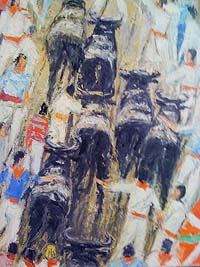
Our habit is to arrive the day before the fiesta begins. We meet our landlord in a favorite bar across the street from our piso and buy him a drink. While sipping this first glass of rosado, we keep an eye out for a couple of strapping Aussies to entice to haul our bags up to the sixth floor in exchange for an invitation to return one morning later in the week to watch the encierro from our balcony. We’ve made a few friends that way, and given a few first-time-at-the-fiesta-boys a chance to see the run before they try. Most important, we’ve preserved our backs for the days of bar-standing and wild-dancing ahead.
There is a bullfight the night before the fiesta starts: the novillada for young matadors just coming of age. Our gang of early-arrivers gathers and greet and go to the bullring. It’s odd to see each other in regular colored clothing; it’s not until the next day at noon, during the opening Chupinazo, when the gun goes off that an entire city dressed in white ties red pañuelos around their necks, raises a glass or a bottle and the fiesta begins. The back balcony of the opening party we usually attend looks out at a cathedral with an enormous bell that rings only a few occasions during the year, this being one of them. After the noon gun, we race back to the back balcony to hear it toll. The sun is high in the sky, the Navarran hills peak in the distance, the fiesta has started but all of it is still before me: days of dance, drink and delight.
Later that evening, if we’re privileged enough to have a ticket to the bullfight, we migrate with the masses toward the corrida. There is kind of an electric buzz as everyone enters the arena, their white clothes still clean and pressed as hugs and kisses are passed around, warm salutations for those seated in the nearby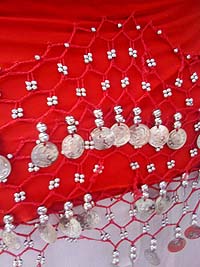 seats, fiesta friends not seen since this time last year. The habitual questions: When did you arrive? When will you leave? Some people surprised that I can stay so long, until Day 12. Others, more seasoned, dismayed that I must leave before the fiesta is finished. Each year it pains me to leave early, but Short-pants celebrates her birthday on Day 13, and I refuse to dampen her party by not appearing. But now is not the time to think of my departure. I scan the bullring, a marvel of white and red, I think about the week ahead, a stretch of six days and nights with revelry and music and laughing still in front of me, it seems like plenty of time, the end of the fiesta for me is ages away.
seats, fiesta friends not seen since this time last year. The habitual questions: When did you arrive? When will you leave? Some people surprised that I can stay so long, until Day 12. Others, more seasoned, dismayed that I must leave before the fiesta is finished. Each year it pains me to leave early, but Short-pants celebrates her birthday on Day 13, and I refuse to dampen her party by not appearing. But now is not the time to think of my departure. I scan the bullring, a marvel of white and red, I think about the week ahead, a stretch of six days and nights with revelry and music and laughing still in front of me, it seems like plenty of time, the end of the fiesta for me is ages away.
The days of the fiesta pass. Some rituals are strictly observed and others spontaneously abandoned. Many fiesta friends, it seems, were celebrating milestone anniversaries this year. Mother Theresa, close friend and part of the cuadrilla I run with fêted her 10th year of attending the fiesta. A good friend was honored several times because this was his 50th consecutive year at San Fermín. Another counted this as his 40th anniversary. Then there were new friends who joined the debauchery this year for the first time, falling into our circle and marking (hopefully) the first of what might turn into their long run of fiestas.
Each day of the fiesta is intense, living a week’s worth of emotions in 24 hours, the highs and lows like a giant sine wave. I had moments of pure alegria: listening to those cathedral bells ring with friends on that back balcony after the opening gun; one afternoon happening upon a few people lying in the grass with their feet raised in the air against a fence, joining them and then, surprised to hear their voices raise together in Basque folksongs; dancing wildly until 3 am, or all the night and sleeping through breakfast; doubling in hysterics at jokes I didn’t even understand – something about the Bronze Age – just because the laughter of my friends was too contagious not to join them. The lows, of course, as crushing as the highs were exhilarating: a misunderstanding with a friend, a missed lunch invitation, a wave of fatigue so fierce that leaving the fun of the fiesta to sleep for a while is the only recourse.
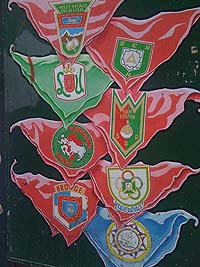 Before I know it, it’s Day 12. At breakfast, I look up and down the table of friends and consider that soon I will have to leave them. All that nonsense about ages to go before my departure vanishes, in what feels like the single wave of a matador’s capote, the week has flashed by and I’m already saying my goodbyes. Polite nods to neighbors at the bullring, hugs across the bar to barmen who’ve served me well all week, tears and long embraces with friends I won’t see for another year. The sound of my suitcase wheels on the stones as I roll it down the street away from the fiesta while it rages behind me – this is the saddest ballad I sing every year.
Before I know it, it’s Day 12. At breakfast, I look up and down the table of friends and consider that soon I will have to leave them. All that nonsense about ages to go before my departure vanishes, in what feels like the single wave of a matador’s capote, the week has flashed by and I’m already saying my goodbyes. Polite nods to neighbors at the bullring, hugs across the bar to barmen who’ve served me well all week, tears and long embraces with friends I won’t see for another year. The sound of my suitcase wheels on the stones as I roll it down the street away from the fiesta while it rages behind me – this is the saddest ballad I sing every year.
A taxi ride to the frontier and a train ride to France is just long enough for two catnaps that allow a reasonably cheerful arrival. De-facto, who’s survived two weeks as a single parent, folds me into his arms. I get the run-and-hug-and-cling welcome from my daughters, who seem notably taller than when I saw them last. I return to the quiet of the country house, lingering morning cuddles in bed with the girls, the smell of a baking birthday cake in the oven. The boom-boom-boom of the fiesta seems far away, and it is, I suppose, until next year, when those six days will once again stretch ahead of me with all their promise, and the end of the fiesta will feel, once again, ages away.
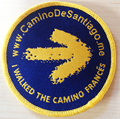
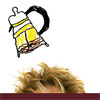
July 15th, 2011 at 12:05 pm
Another wild, fun-filled fiesta! Even though it’s sad to see you leave on day 11, you can be consoled by the fact that the ‘Pamplona crud’ hasn’t had time to settle into your throat, lungs and digestive tract! This is always the case with me!
One of my fiesta highlights was dancing to the ersatz Blues Brothers band. And you were there!!! We have to turn all the young Spaniards on to those sounds!
The Nazi, Mother Theresa, Eric and I had a few glasses of wine and some tapas yesterday at lunch time in Bar Cordovilla, the Mussel Bar and Bar Burgos. We had fun but it wasn’t the same without you!!!
It was great to see you and I hope we have a chance to see you (hopefully in Paree at Le Petit Fer) before too long. Un beso, Tom
July 15th, 2011 at 2:40 pm
I wish your post was longer so I could relive everything. Loved it. I remember coming in on Day 5 to meet you guys, in a measured, rational mood, and then all of a sudden wanting to jump up and down and scream. The only bad thing about San Fermín is leaving.